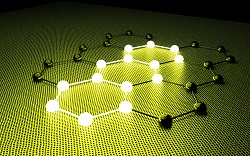An EU project is making waves in the laser industry
There are many applications within industries ranging from communications (e.g. free space communication), to security (e.g. missile counter-measures) and to sensing (e.g. explosives), which would benefit from laser sources that are both compact and cost-effective. Gaps in the spectrum, especially much of the far-infrared and THz, hold out promise for the development of new sources. At the same time, Free Electron Lasers (FELs) offer a radical alternative to conventional lasers being potentially the most efficient, high powered and flexible generators of tuneable coherent radiation from the ultra-violet to the infrared. However, currently FELs are prohibitively large and expensive. The GOSFEL (Graphene on Silicon Free Electron Laser) project exploited the recently identified, special qualities of graphene. In doing so it achieved what project coordinator Prof. Geoffrey Nash has referred to as a long held goal of physicists and engineers, namely, to create a compact, relatively inexpensive, solid-state version of such a laser. From theory, to design and build The GOSFEL project’s first priority was to advance a theoretical understanding of the underlying physics and principles, before going on to design and construct a graphene-metamaterial hybrid, functioning as a laser cavity and significantly boosting the light-graphene-interaction. FELs typically work when electron beams emit radiation by travelling in a vacuum and passing through an undulatory magnetic field. The emission wavelength is established by the electron beam energy and the period of the magnetic field. Rather than use a magnetic field, the GOSFEL team came up with a new structure, based on patterning of the graphene, to accelerate/decelerate electrons to make them emit radiation in the range of 0.2 to 10 THz. Devices incorporating this structure are currently being tested and the team is confident that they will demonstrate the principle of operation over the next few months. In addition, a new electromagnetic feedback cavity has been developed in parallel and will ultimately be integrated into the device. One, somewhat unexpected consequence, of the hybrid device was that as Prof. Nash puts it, ‘The graphene metamaterial hybrid was developed to act as the cavity for the laser, but we found that it also acts as an exiting platform to study the physics of light-matter interactions.’ Numerous applications Prof. Nash points out that GOSFEL’s demonstration of a graphene based FEL would challenge prevailing views about laser operation (such as room temperature operability), as well as offering the prospect of progress on a number of research and development fronts. A new graphene based component industry (possibly offering cheaper devices than the current semiconductor based ones) is likely to be of great interest to sensor, analyser and instrument manufacturers. When asked about some of the likely specific applications, Prof. Nash states that, ‘We have already demonstrated beyond state-of-the-art THz modulators that could be used as part of future communications systems, and also cavity enhanced graphene based photodetectors.’ He goes on to assert that, ‘The tunability of the hybrid modes provides a route toward spectrometer-free sensing, which combined with the integrated detector, opens up the possibility of highly sensitive, low-cost, and miniaturized sensors for point of-care medical applications for example.” He adds that the technology could also inaugurate new sensors for more effective monitoring of atmospheric pollutants, such as nitrogen dioxide, leading to better mitigation and control measures. Looking to the future, the professor asserts that once the right funding is secured, the work will build on these proof-of-principle modulator and detector devices and will build prototypes of interest to component and sensor industries. For more information, please see: project website
Countries
United Kingdom



